Genetic Diversity and Association Analysis of Traits Related to Water-Use Efficiency and Nitrogen-Use Efficiency of Populus deltoides Based on SSR Markers
Abstract
:1. Introduction
2. Results
2.1. Performance and Correlation of WUE and NUE
2.2. Genetic Differentiation and Genetic Diversity Analysis of P. deltoides Populations
2.3. Population Structure and Phylogenetic Relationships
2.4. SSR Linkage Disequilibrium Analysis and Trait-Marker Association
3. Discussion
4. Materials and Methods
4.1. Test Materials
4.2. Growth and Physiological Trait Determination
4.3. DNA Extraction and Primer Amplification
4.4. Data Processing
5. Conclusions
Supplementary Materials
Author Contributions
Funding
Institutional Review Board Statement
Informed Consent Statement
Data Availability Statement
Acknowledgments
Conflicts of Interest
References
- Downing, M.; Eaton, L.M.; Graham, R.L.; Langholtz, M.H.; Perlack, R.D.; Turhollow, A.F., Jr.; Stokes, B.; Brandt, C.C. US Billion-ton Update: Biomass Supply for a Bioenergy and Bioproducts Industry; Oak Ridge National Lab. (ORNL): Oak Ridge, TN, USA, 2011. [Google Scholar]
- Lv, Z.; Liu, F.; Zhang, Y.; Tu, Y.; Chen, P.; Peng, L. Ecologically adaptable Populus simonii is specific for recalcitrance-reduced lignocellulose and largely enhanced enzymatic saccharification among woody plants. GCB Bioenergy 2021, 13, 348–360. [Google Scholar] [CrossRef]
- Chen, C.; Chu, Y.; Huang, Q.; Zhang, W.; Ding, C.; Zhang, J.; Li, B.; Zhang, T.; Li, Z.; Su, X. Morphological, physiological, and transcriptional responses to low nitrogen stress in Populus deltoides Marsh. clones with contrasting nitrogen use efficiency. BMC Genom. 2021, 22, 1–18. [Google Scholar] [CrossRef] [PubMed]
- Sun, P.; Jia, H.; Zhang, Y.; Li, J.; Lu, M.; Hu, J. Deciphering genetic architecture of adventitious root and related shoot traits in Populus using QTL mapping and RNA-Seq data. Int. J. Mol. Sci. 2019, 20, 6114. [Google Scholar] [CrossRef] [PubMed]
- Tun, T.N.; Guo, J.; Fang, S.; Tian, Y. Planting spacing affects canopy structure, biomass production and stem roundness in poplar plantations. Scand. J. Forest. Res. 2018, 33, 464–474. [Google Scholar] [CrossRef]
- Chen, W.; Meng, C.; Ji, J.; Li, M.; Zhang, X.; Wu, Y.; Xie, T.; Du, C.; Sun, J.; Jiang, Z. Exogenous GABA promotes adaptation and growth by altering the carbon and nitrogen metabolic flux in poplar seedlings under low nitrogen conditions. Tree Physiol. 2020, 40, 1744–1761. [Google Scholar] [CrossRef]
- Zhang, Y.; Wang, N.; Yang, L.; Liu, N.; Peng, R.; Yu, L.; Liu, F.; Wang, S.; Gao, C.; Ji, J.; et al. Effects of fertilization and drip irrigation on the growth of Populus × canadensis ‘Zhongliao 1’ plantation and on soil physicochemical properties and enzyme activities. Forests 2024, 15, 1651. [Google Scholar] [CrossRef]
- Toillon, J.; Dallé, E.; Bodineau, G.; Berthelot, A.; Bastien, J.C.; Brignolas, F.; Marron, N. Plasticity of yield and nitrogen removal in 56 Populus deltoides× P. nigra genotypes over two rotations of short-rotation coppice. For. Ecol. Manag. 2016, 375, 55–65. [Google Scholar] [CrossRef]
- Jassal, R.S.; Black, T.A.; Arevalo, C.; Jones, H.; Bhatti, J.S.; Sidders, D. Carbon sequestration and water use of a young hybrid poplar plantation in north-central Alberta. Biomass Bioenergy 2013, 56, 323–333. [Google Scholar] [CrossRef]
- Monclus, R.; Dreyer, E.; Villar, M.; Delmotte, F.M.; Delay, D.; Petit, J.M.; Barbaroux, C.; Le Thiec, D.; Bréchet, C.; Brignolas, F. Impact of drought on productivity and water use efficiency in 29 genotypes of Populus deltoides× Populus nigra. New Phytol. 2006, 169, 765–777. [Google Scholar] [CrossRef]
- Gao, C.; Liu, C.; Chen, C.; Liu, N.; Liu, F.; Su, X.; Huang, Q. Genetic evaluation of water use efficiency and nutrient use efficiency in Populus deltoides Bartr. ex Marsh. seedlings in China. Plants 2024, 13, 2228. [Google Scholar] [CrossRef]
- Su, X.; Ding, C.; Ma, C. Research progress and strategies of poplar breeding in China. Forest Res. 2010, 23, 31–37. (In Chinese) [Google Scholar]
- Ma, C. Researches on poplar breeding in China to be viewed in the light of the development and achievement of cross breeding of poplars in the world. World For. Res. 1994, 3, 23–30. (In Chinese) [Google Scholar]
- Pégard, M.; Segura, V.; Muñoz, F.; Bastien, C.; Jorge, V.; Sanchez, L. Favorable conditions for genomic evaluation to outperform classical pedigree evaluation highlighted by a proof-of-concept study in poplar. Front. Plant Sci. 2020, 11, 581954. [Google Scholar] [CrossRef] [PubMed]
- Arifuzzaman, M.; Mamidi, S.; Sanz-Saez, A.; Zakeri, H.; Scaboo, A.; Fritschi, F.B. Identification of loci associated with water use efficiency and symbiotic nitrogen fixation in soybean. Front. Plant Sci. 2023, 14, 1271849. [Google Scholar] [CrossRef]
- Mateus, N.d.S.; Florentino, A.L.; Santos, E.F.; Ferraz, A.d.V.; Goncalves, J.L.d.M.; Lavres, J. Partial substitution of K by Na alleviates drought stress and increases water use efficiency in Eucalyptus species seedlings. Front. Plant Sci. 2021, 12, 632342. [Google Scholar]
- Mininni, A.N.; Tuzio, A.C.; Brugnoli, E.; Dichio, B.; Sofo, A. Carbon isotope discrimination and water use efficiency in interspecific Prunus hybrids subjected to drought stress. Plant Physiol. Biochem. 2022, 175, 33–43. [Google Scholar] [CrossRef]
- Quan, Z.; Zhang, X.; Fang, Y.; Davidson, E.A. Different quantification approaches for nitrogen use efficiency lead to divergent estimates with varying advantages. Nat. Food 2021, 2, 241–245. [Google Scholar] [CrossRef]
- Wan, X.; Wu, W.; Liao, Y. Agricultural water management mitigating ammonia volatilization and increasing nitrogen use efficiency through appropriate nitrogen management under supplemental irrigation and rain–fed condition in winter wheat. Agr. Water Manag. 2021, 255, 107050. [Google Scholar] [CrossRef]
- Al-Tawaha, A.R.M.S.; Singh, S.; Singh, V. Improving Water Use Efficiency and Nitrogen Use Efficiency in Rice Through Breeding and Genomics Approaches, in Rice Research for Quality Improvement: Genomics and Genetic Engineering; Springer: Singapore, 2020; pp. 307–337. [Google Scholar]
- Cortés, A.J.; Du, H. Molecular genetics enhances plant breeding. Int. J. Mol. Sci. 2023, 24, 9977. [Google Scholar] [CrossRef]
- Chen, J.; Chang, S.X.; Anyia, A.O. Gene discovery in cereals through quantitative trait loci and expression analysis in water-use efficiency measured by carbon isotope discrimination. Plant Cell Environ. 2011, 34, 2009–2023. [Google Scholar] [CrossRef]
- Pujarula, V.; Pusuluri, M.; Bollam, S.; Das, R.R.; Ratnala, R.; Adapala, G.; Thuraga, V.; Rathore, A.; Srivastava, R.K.; Gupta, R. Genetic variation for nitrogen use efficiency traits in global diversity panel and parents of mapping populations in pearl millet. Front. Plant Sci. 2021, 12, 625915. [Google Scholar] [CrossRef] [PubMed]
- Du, Q.; Gong, C.; Wang, Q.; Zhou, D.; Yang, H.; Pan, W.; Li, B.; Zhang, D. Genetic architecture of growth traits in Populus revealed by integrated quantitative trait locus (QTL) analysis and association studies. New Phytol. 2016, 209, 1067–1082. [Google Scholar] [CrossRef] [PubMed]
- Du, Q.; Xu, B.; Pan, W.; Gong, C.; Wang, Q.; Tian, J.; Li, B.; Zhang, D. Allelic variation in a cellulose synthase gene (PtoCesA4) associated with growth and wood properties in Populus tomentosa. G3 Genes Genomes Genet. 2013, 3, 2069–2084. [Google Scholar] [CrossRef] [PubMed]
- Wu, J.; Cheng, F.; Cai, C.; Zhong, Y.; Jie, X. Association mapping for floral traits in cultivated Paeonia rockii based on SSR markers. Mol. Genet. Genom. 2017, 292, 187–200. [Google Scholar] [CrossRef] [PubMed]
- Hansen, M.; Kraft, T.; Ganestam, S.; Saell, T.; Nilsson, N.O. Linkage disequilibrium mapping of the bolting gene in sea beet using AFLP markers. Genet. Res. 2001, 77, 61–66. [Google Scholar] [CrossRef]
- Beer, S.; Siripoonwiwat, W.; O’donoughue, L.; Souza, E.; Matthews, D.; Sorrells, M. Associations between molecular markers and quantitative traits in an oat germplasm pool: Can we infer linkages. J. Exp. Bot. 1997, 3, 197. [Google Scholar]
- Breseghello, F.; Sorrells, M.E. Association mapping of kernel size and milling quality in wheat (Triticum aestivum L.) cultivars. Genetics 2006, 172, 1165–1177. [Google Scholar] [CrossRef]
- Huang, X.; Zhao, Y.; Wei, X.; Li, C.; Wang, A.; Zhao, Q.; Li, W.; Guo, Y.; Deng, L.; Zhu, C. Genome-wide association study of flowering time and grain yield traits in a worldwide collection of rice germplasm. Nat. Genet. 2012, 44, 32–39. [Google Scholar] [CrossRef]
- Garrido-Cardenas, J.A.; Mesa-Valle, C.; Manzano-Agugliaro, F. Trends in plant research using molecular markers. Planta 2018, 247, 543–557. [Google Scholar] [CrossRef]
- Gupta, P.; Balyan, H.; Sharma, P.; Ramesh, B. Microsatellites in plants: A new class of molecular markers. Curr. Sci. India 1996, 70, 45–54. [Google Scholar]
- Wang, L.; Wang, B.L.; Wei, Z.Z.; Du, Q.Z.; Zhang, D.Q.; Li, B.L. Development of 35 microsatellite markers from heat stress transcription factors in Populus simonii (Salicaceae). Am. J. Bot. 2012, 99, e357–e361. [Google Scholar] [CrossRef] [PubMed]
- Fahrenkrog, A.M.; Neves, L.G.; Resende Jr, M.F.; Vazquez, A.I.; de Los Campos, G.; Dervinis, C.; Sykes, R.; Davis, M.; Davenport, R.; Barbazuk, W.B. Genome-wide association study reveals putative regulators of bioenergy traits in Populus deltoides. New Phytol. 2017, 213, 799–811. [Google Scholar] [CrossRef] [PubMed]
- Ingvarsson, P.K.; Garcia, M.V.; Luquez, V.; Hall, D.; Jansson, S. Nucleotide polymorphism and phenotypic associations within and around the phytochrome B2 locus in European aspen (Populus tremula, Salicaceae). Genetics 2008, 178, 2217–2226. [Google Scholar] [CrossRef] [PubMed]
- Zhang, X.; Gu, C.; Zhang, T.; Tong, B.; Zhang, H.; Wu, Y.; Yang, C. Chloroplast (Cp) Transcriptome of P. davidiana Dode× P. bolleana Lauch provides insight into the Cp drought response and Populus Cp phylogeny. BMC Evol. Biol. 2020, 20, 1–14. [Google Scholar] [CrossRef]
- Rosso, L.; Cantamessa, S.; Bergante, S.; Biselli, C.; Fricano, A.; Chiarabaglio, P.M.; Gennaro, M.; Nervo, G.; Secchi, F.; Carra, A. Responses to drought stress in poplar: What do we know and what can we learn? Life 2023, 13, 533. [Google Scholar] [CrossRef]
- Ma, J.; Wan, D.; Duan, B.; Bai, X.; Bai, Q.; Chen, N.; Ma, T. Genome sequence and genetic transformation of a widely distributed and cultivated poplar. Plant Biotechnol. J. 2019, 17, 451–460. [Google Scholar] [CrossRef]
- Zasada, J.; David, A.; Gilmore, D.; Landhausser, S. Ecology and silviculture of natural stands of Populus species. In Poplar Culture in North America; NRC Research Press: Ottawa, ON, Canada, 2001; pp. 119–151. [Google Scholar]
- Chen, C.; Chu, Y.; Ding, C.; Su, X.; Huang, Q. Genetic diversity and population structure of black cottonwood (Populus deltoides) revealed using simple sequence repeat markers. BMC Genet. 2020, 21, 1–12. [Google Scholar] [CrossRef]
- Stanton, B.J.; Neale, D.B.; Li, S. Populus breeding: From the classical to the genomic approach. In Genetics and Genomics of Populus; Springer: Berlin/Heidelberg, Germany, 2009; pp. 309–348. [Google Scholar]
- Lv, Y.; Lu, Y.; Fang, S.Z.; Tian, Y.; Xu, X. Genetic variation in growth and wood properties for southern type poplar clones. J. Nanjing For. Univ. 2018, 42, 20–26. (In Chinese) [Google Scholar]
- Yang, S.; Shi, J.; Chen, L.; Zhang, J.; Zhang, D.; Xu, Z.; Xiao, J.; Zhu, P.; Liu, Y.; Lin, T.; et al. Physiological and biomass partitioning shifts to water stress under distinct soil types in Populus deltoides saplings. J. Plant Ecol. 2020, 13, 545–553. [Google Scholar] [CrossRef]
- Shi, Q.; Tian, D.; Wang, J.; Chen, A.; Miao, Y.; Chen, Y.; Li, J.; Wu, X.; Zheng, B.; Guo, W.; et al. Overexpression of miR390b promotes stem elongation and height growth in Populus. Hortic. Res. 2023, 10, 258. [Google Scholar] [CrossRef]
- O’Neill, M.K.; Allen, S.C.; Heyduck, R.F.; Lombard, K.A.; Smeal, D.; Arnold, R.N. Hybrid poplar: A potential multipurpose tree for drip irrigation in semi-arid temperate regions. In Proceedings of the XIV World Forestry Congress, Durban, South Africa, 7–11 September 2015. [Google Scholar]
- You, H.; Wang, C.; Zhao, G.; Li, D. Distribution characteristics of Populus euramericana nocturnalsap flowand its response to environmental factors in North China Plain. Ecol. Environ. Sci. 2023, 32, 256–263. (In Chinese) [Google Scholar]
- Rivera, A.; Monteagudo, A.B.; Igartua, E.; Taboada, A.; García-Ulloa, A.; Pomar, F.; Riveiro-Leira, M.; Silvar, C. Assessing genetic and phenotypic diversity in pepper (Capsicum annuum L.) landraces from North-West Spain. Sci. Hortic. 2016, 203, 1–11. [Google Scholar] [CrossRef]
- Yin, C.; Wang, X.; Duan, B.; Luo, J.; Li, C. Early growth, dry matter allocation and water use efficiency of two sympatric Populus species as affected by water stress. Environ. Exp. Bot. 2005, 53, 315–322. [Google Scholar] [CrossRef]
- Scribner, K.T.; Uhrig, G.; Kanefsky, J.; Sard, N.M.; Holtgren, M.; Jerome, C.; Ogren, S. Pedigree-based decadal estimates of lake sturgeon adult spawning numbers and genetic diversity of stream-side hatchery produced offspring. J. Great Lakes Res. 2022, 48, 551–564. [Google Scholar] [CrossRef]
- Khoury, C.K.; Brush, S.; Costich, D.E.; Curry, H.A.; De Haan, S.; Engels, J.M.; Guarino, L.; Hoban, S.; Mercer, K.L.; Miller, A.J. Crop genetic erosion: Understanding and responding to loss of crop diversity. New Phytol. 2022, 233, 84–118. [Google Scholar] [CrossRef]
- Ingvarsson, P.K. Multilocus patterns of nucleotide polymorphism and the demographic history of Populus tremula. Genetics 2008, 180, 329–340. [Google Scholar] [CrossRef]
- Teixeira, J.C.; Huber, C.D. The inflated significance of neutral genetic diversity in conservation genetics. Proc. Natl. Acad. Sci. USA 2021, 118, e2015096118. [Google Scholar] [CrossRef]
- Du, Q.; Pan, W.; Xu, B.; Li, B.; Zhang, D. Polymorphic simple sequence repeat (SSR) loci within cellulose synthase (PtoCesA) genes are associated with growth and wood properties in Populus tomentosa. New Phytol. 2012, 197, 763–776. [Google Scholar] [CrossRef]
- Wu, Q.; Zang, F.; Ma, Y.; Zheng, Y.; Zang, D. Analysis of genetic diversity and population structure in endangered Populus wulianensis based on 18 newly developed EST-SSR markers. Glob. Ecol. Conserv. 2020, 24, e01329. [Google Scholar] [CrossRef]
- Kumar Yadav, H.; Ranjan, A.; Asif, M.H.; Mantri, S.; Sawant, S.V.; Tuli, R. EST-derived SSR markers in Jatropha curcas L.: Development, characterization, polymorphism, and transferability across the species/genera. Tree Genet. Genomes 2011, 7, 207–219. [Google Scholar] [CrossRef]
- Botstein, D.; White, R.L.; Skolnick, M.; Davis, R.W. Construction of a genetic linkage map in man using restriction fragment length polymorphisms. Am. J. Hum. Genet. 1980, 32, 314. [Google Scholar] [PubMed]
- Boudchicha, R.; Hormaza, J.; Benbouza, H. Diversity analysis and genetic relationships among local Algerian fig cultivars (Ficus carica l.) using SSR markers. S. Afr. J. Bot. 2018, 116, 207–215. [Google Scholar] [CrossRef]
- Pearse, D.E.; Crandall, K.A. Beyond F ST: Analysis of population genetic data for conservation. Conserv. Genet. 2004, 5, 585–602. [Google Scholar] [CrossRef]
- Hou, Z.; Li, A. Population genomics reveals demographic history and genomic differentiation of Populus davidiana and Populus tremula. Front. Plant Sci. 2020, 11, 1103. [Google Scholar] [CrossRef]
- Smith, A.L.; Hodkinson, T.R.; Villellas, J.; Catford, J.A.; Csergő, A.M.; Blomberg, S.P.; Crone, E.E.; Ehrlén, J.; Garcia, M.B.; Laine, A.-L. Global gene flow releases invasive plants from environmental constraints on genetic diversity. Proc. Natl. Acad. Sci. USA 2020, 117, 4218–4227. [Google Scholar] [CrossRef]
- Mushtaq, N.U.; Saleem, S.; Shah, W.H.; Rehman, R.U. Dispersal, gene flow, and population structure. In Plant Ecogenomics; Apple Academic Press: Palm Bay, FL, USA, 2022; pp. 139–156. [Google Scholar]
- Xue, Y.; Liu, R.; Xue, J.; Wang, S.; Zhang, X. Genetic diversity and relatedness analysis of nine wild species of tree peony based on simple sequence repeats markers. Hortic. Plant J. 2021, 7, 579–588. [Google Scholar] [CrossRef]
- Slavov, G.T.; Zhelev, P. Salient biological features, systematics, and genetic variation of Populus. In Genetics and Genomics of Populus: Plant Genetics and Genomics: Crops and Models; Springer: New York, NY, USA, 2010; pp. 15–38. [Google Scholar]
- Hall, D.; Luquez, V.; Garcia, V.M.; St Onge, K.R.; Jansson, S.; Ingvarsson, P.K. Adaptive population differentiation in phenology across a latitudinal gradient in European aspen (Populus tremula, L.): A comparison of neutral markers, candidate genes and phenotypic traits. Evolution 2007, 61, 2849–2860. [Google Scholar] [CrossRef]
- Liao, R.; Luo, Y.; Yisilam, G.; Lu, R.; Wang, Y.; Li, P. Development and characterization of SSR markers for sanguinaria canadensis based on genome skimming. Appl. Plant Sci. 2019, 7, e112879. [Google Scholar] [CrossRef]
- King, R.A.; Harris, S.L.; Karp, A.; Barker, J.H. Characterisation and inheritance of nuclear microsatellite loci for use in population studies of the allotetraploid Salix alba–Salix fragilis complex. Tree Genet. Genomes 2010, 6, 247–258. [Google Scholar] [CrossRef]
- Li, L.; Du, J.; Ma, L.; Ding, C.; Zhang, P.; Kang, X. Regional testing of triploid hybrid clones of Populus tomentosa. BMC Plant Biol. 2023, 23, 277. [Google Scholar] [CrossRef]
- Yang, Y.; He, R.; Zheng, J.; Hu, Z.; Wu, J.; Leng, P. Development of EST-SSR markers and association mapping with floral traits in Syringa oblata. BMC Plant Biol. 2020, 20, 1–13. [Google Scholar] [CrossRef] [PubMed]
- Flint-Garcia, S.A.; Thornsberry, J.M.; Buckler IV, E.S. Structure of linkage disequilibrium in plants. Annu. Rev. Plant Biol. 2003, 54, 357–374. [Google Scholar] [CrossRef] [PubMed]
- Chhetri, H.B.; Macaya-Sanz, D.; Kainer, D.; Biswal, A.K.; Evans, L.M.; Chen, J.G.; Collins, C.; Hunt, K.; Mohanty, S.S.; Rosenstiel, T. Multitrait genome-wide association analysis of Populus trichocarpa identifies key polymorphisms controlling morphological and physiological traits. New Phytol. 2019, 223, 293–309. [Google Scholar] [CrossRef] [PubMed]
- Du, Q.; Pan, W.; Tian, J.; Li, B.; Zhang, D. The UDP-glucuronate decarboxylase gene family in Populus: Structure, expression, and association genetics. PLoS ONE 2013, 8, e60880. [Google Scholar] [CrossRef] [PubMed]
- Külheim, C.; Hui Yeoh, S.; Maintz, J.; Foley, W.J.; Moran, G.F. Comparative SNP diversity among four Eucalyptus species for genes from secondary metabolite biosynthetic pathways. BMC Genom. 2009, 10, 1–11. [Google Scholar] [CrossRef]
- Cai, C.; Ye, W.; Zhang, T.; Guo, W. Association analysis of fiber quality traits and exploration of elite alleles in upland cotton cultivars/accessions (Gossypium hirsutum L.). J. Integr. Plant Biol. 2014, 56, 51–62. [Google Scholar] [CrossRef]
- Labrador, M.; Farré, M.; Utzet, F.; Fontdevila, A. Interspecific hybridization increases transposition rates of Osvaldo. Mol. Biol. Evol. 1999, 16, 931–937. [Google Scholar] [CrossRef]
- Morrell, P.L.; Toleno, D.M.; Lundy, K.E.; Clegg, M.T. Low levels of linkage disequilibrium in wild barley (Hordeum vulgare ssp. spontaneum) despite high rates of self-fertilization. Proc. Natl. Acad. Sci. USA 2005, 102, 2442–2447. [Google Scholar]
- Zhang, Q.; Zhang, D.; Yu, K.; Ji, J.; Liu, N.; Zhang, Y.; Xu, M.; Zhang, Y.J.; Ma, X.; Liu, S. Frequent germplasm exchanges drive the high genetic diversity of Chinese-cultivated common apricot germplasm. Hortic. Res. 2021, 8, 215. [Google Scholar] [CrossRef]
- Chu, H.; Tu, R.; Niu, F.; Zhou, J.; Sun, B.; Luo, Z.; Cheng, C.; Cao, L. A New PCR/LDR-based multiplex functional molecular marker for marker-assisted breeding in rice. Rice Sci. 2021, 28, 6. [Google Scholar]
- Duan, X.; Yu, H.; Ma, W.; Sun, J.; Zhao, Y.; Yang, R.; Ning, T.; Li, Q.; Liu, Q.; Guo, T. A major and stable QTL controlling wheat thousand grain weight: Identification, characterization, and CAPS marker development. Mol. Breed. 2020, 40, 1–12. [Google Scholar] [CrossRef]
- Mommer, L.; Visser, E.J.; van Ruijven, J.; de Caluwe, H.; Pierik, R.; de Kroon, H. Contrasting root behaviour in two grass species: A test of functionality in dynamic heterogeneous conditions. Plant Soi. 2011, 344, 347–360. [Google Scholar] [CrossRef]
- Ur Rehman, S.; Wang, J.; Chang, X.; Zhang, X.; Mao, X.; Jing, R. A wheat protein kinase gene TaSnRK2.9-5A associated with yield contributing traits. Theor. Appl. Genet. 2019, 132, 907–919. [Google Scholar] [CrossRef] [PubMed]
- Sean, M.; Jason, P.; Patrick, J.B.; Elhan, S.E.; Zhang, Z.; Denise, E.C.; Edward, S.B. Association mapping: Critical considerations shift from genotyping to experimental design. Plant Cell 2009, 8, 2194–2202. [Google Scholar]
- Lam, H.-M.; Xu, X.; Liu, X.; Chen, W.; Yang, G.; Wong, F.-L.; Li, M.-W.; He, W.; Qin, N.; Wang, B. Resequencing of 31 wild and cultivated soybean genomes identifies patterns of genetic diversity and selection. Nat. Genet. 2010, 42, 1053–1059. [Google Scholar] [CrossRef]
- Beló, A.; Zheng, P.; Luck, S.; Shen, B.; Meyer, D.J.; Li, B.; Tingey, S.; Rafalski, A. Whole genome scan detects an allelic variant of fad2 associated with increased oleic acid levels in maize. Mol. Genet. Genom. 2008, 279, 1–10. [Google Scholar] [CrossRef]
- Cavanagh, C.R.; Chao, S.; Wang, S.; Huang, B.E.; Stephen, S.; Kiani, S.; Forrest, K.; Saintenac, C.; Brown-Guedira, G.L.; Akhunova, A. Genome-wide comparative diversity uncovers multiple targets of selection for improvement in hexaploid wheat landraces and cultivars. Proc. Natl. Acad. Sci. USA 2013, 110, 8057–8062. [Google Scholar] [CrossRef]
- Ding, H.; Zheng, T.; Liang, D.; Qu, G. A simple and efficient method of DNA extraction from different plant samples. Bull. Bot. Res. 2015, 35, 457–461. (In Chinese) [Google Scholar]
- Du, Q.Z.; Zhang, D.Q.; Li, B.L. Development of 15 novel microsatellite markers from cellulose synthase genes in Populus tomentosa (Salicaceae). Am. J. Bot. 2012, 99, 46–48. [Google Scholar] [CrossRef]
- Gomaa, N.H.; Picó, F.X. Depicting the phenotypic space of the annual plant Diplotaxis acris in hyperarid deserts. Ecol. Evol. 2021, 11, 15708–15719. [Google Scholar] [CrossRef]
- Evanno, G.; Regnaut, S.; Goudet, J. Detecting the number of clusters of individuals using the software STRUCTURE: A simulation study. Mol. Ecol. 2005, 14, 2611–2620. [Google Scholar] [CrossRef] [PubMed]
- Hardy, O.J.; Vekemans, X. SPAGeDi: A versatile computer program to analyse spatial genetic structure at the individual or population levels. Mol. Ecol. Notes 2002, 2, 618–620. [Google Scholar] [CrossRef]
- Yu, J.; Pressoir, G.; Briggs, W.H.; Vroh Bi, I.; Yamasaki, M.; Doebley, J.F.; McMullen, M.D.; Gaut, B.S.; Nielsen, D.M.; Holland, J.B. A unified mixed-model method for association mapping that accounts for multiple levels of relatedness. Nat. Genet. 2006, 38, 203–208. [Google Scholar] [CrossRef] [PubMed]
- Bradbury, P.J.; Zhang, Z.; Kroon, D.E.; Casstevens, T.M.; Ramdoss, Y.; Buckler, E.S. TASSEL: Software for association mapping of complex traits in diverse samples. Bioinformatics 2007, 23, 2633–2635. [Google Scholar] [CrossRef]
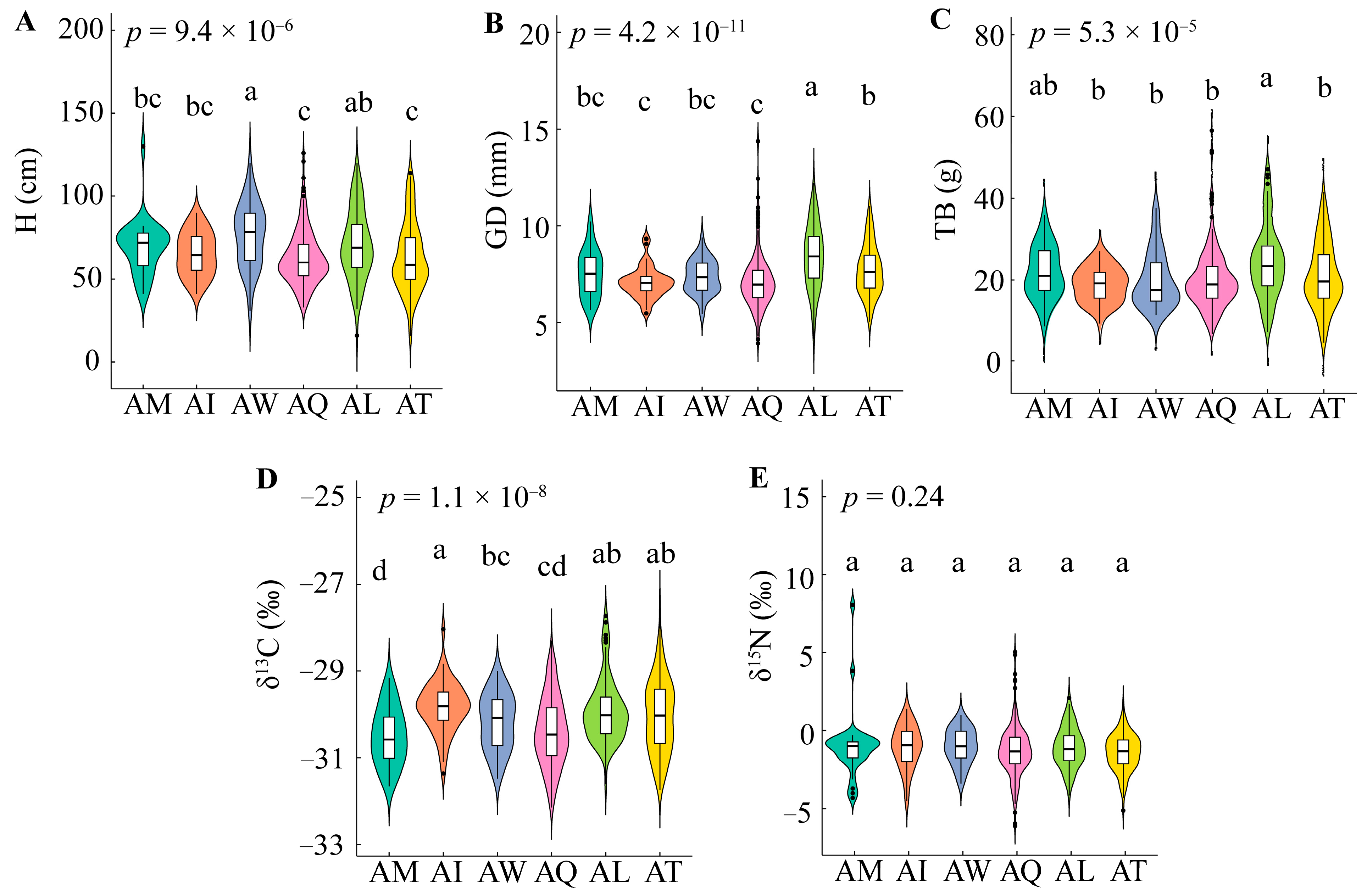
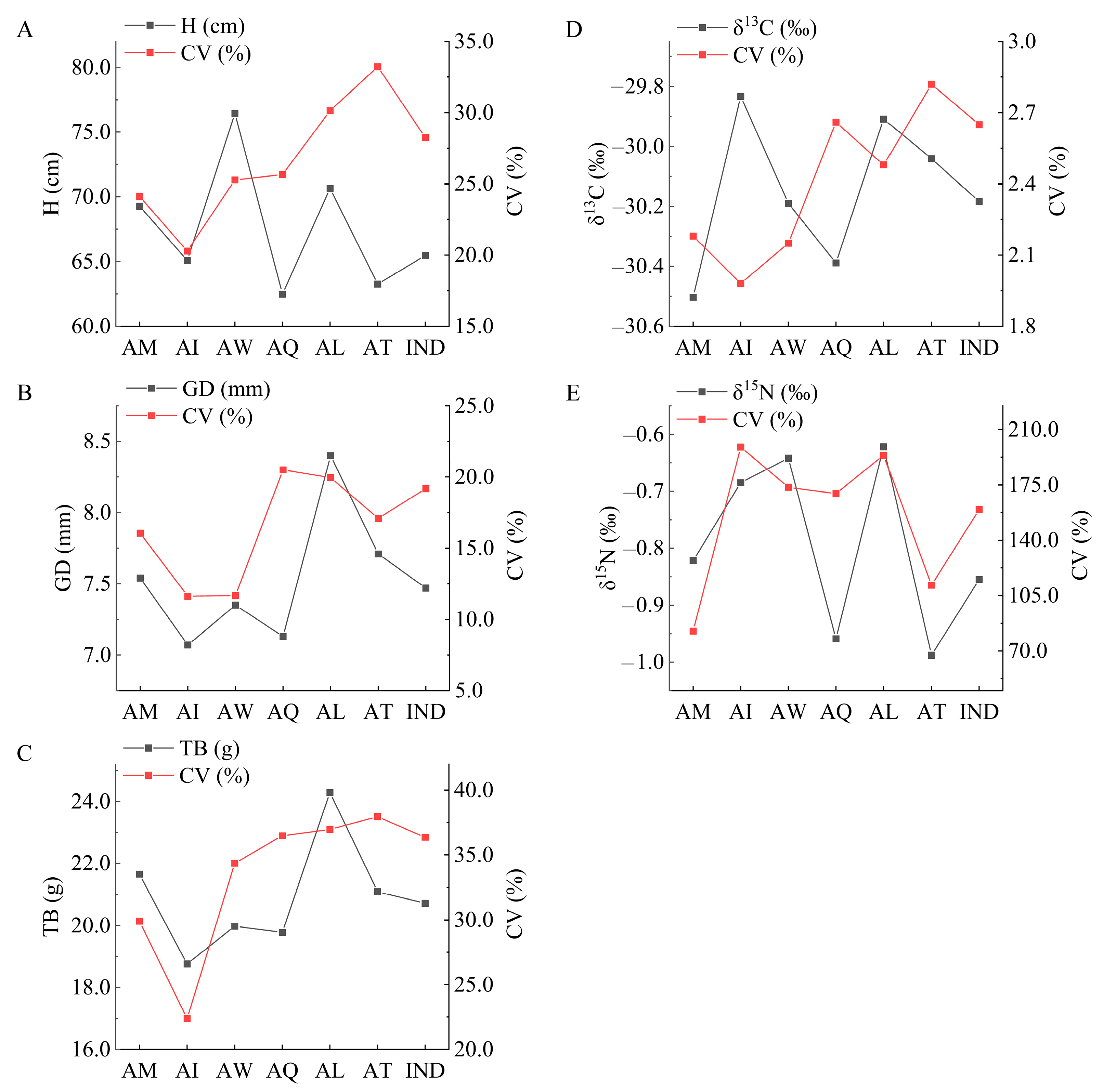
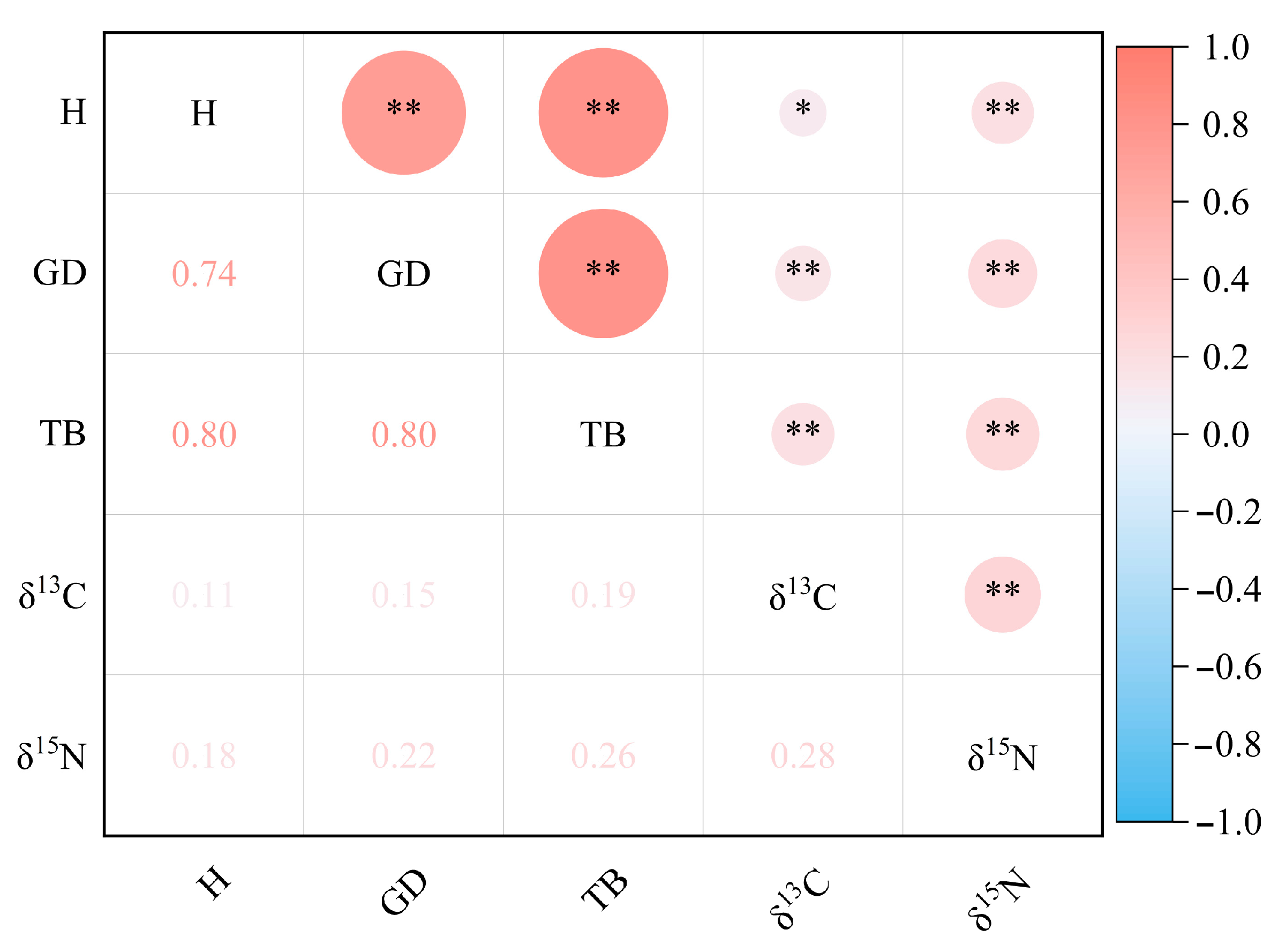

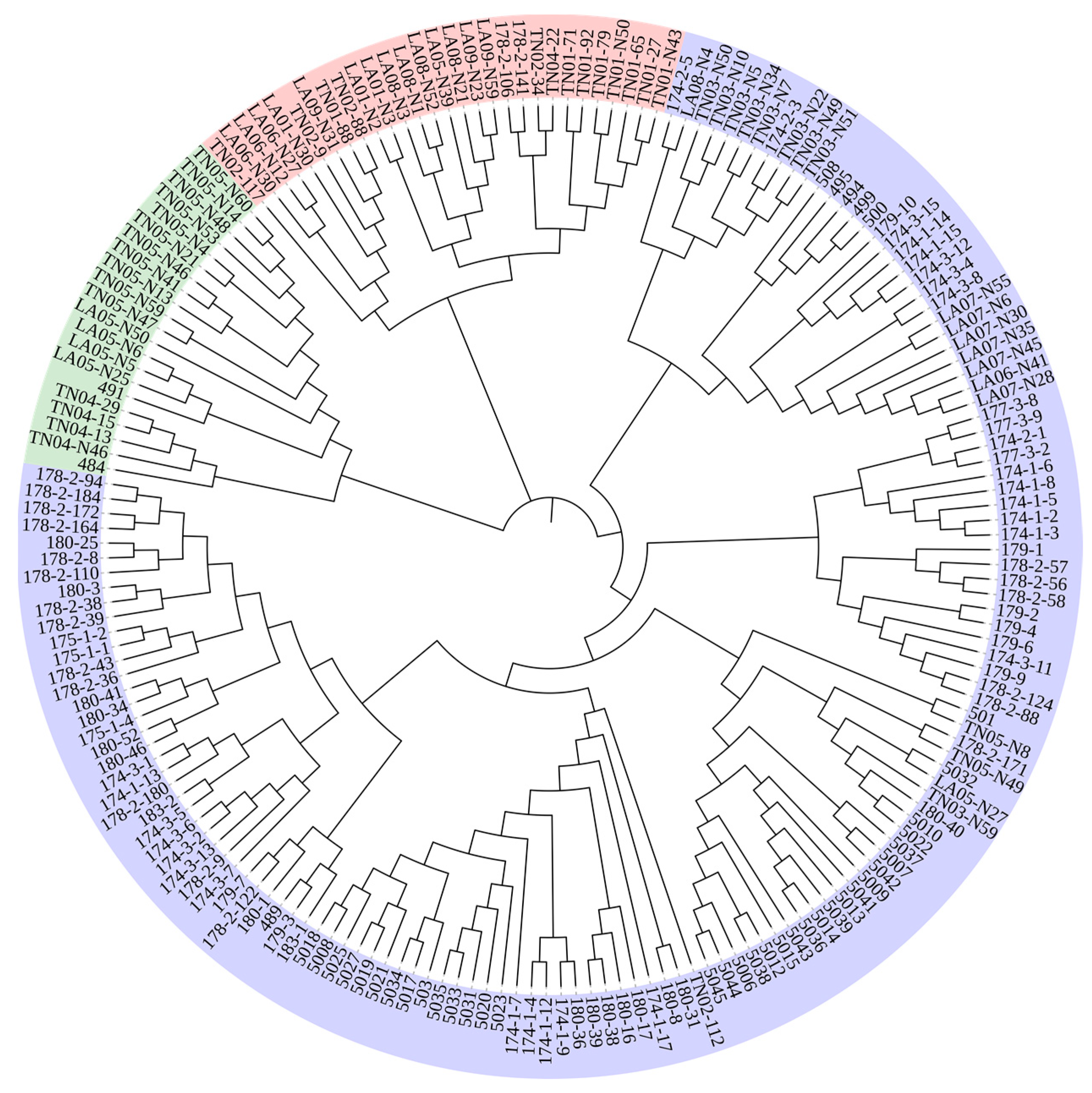
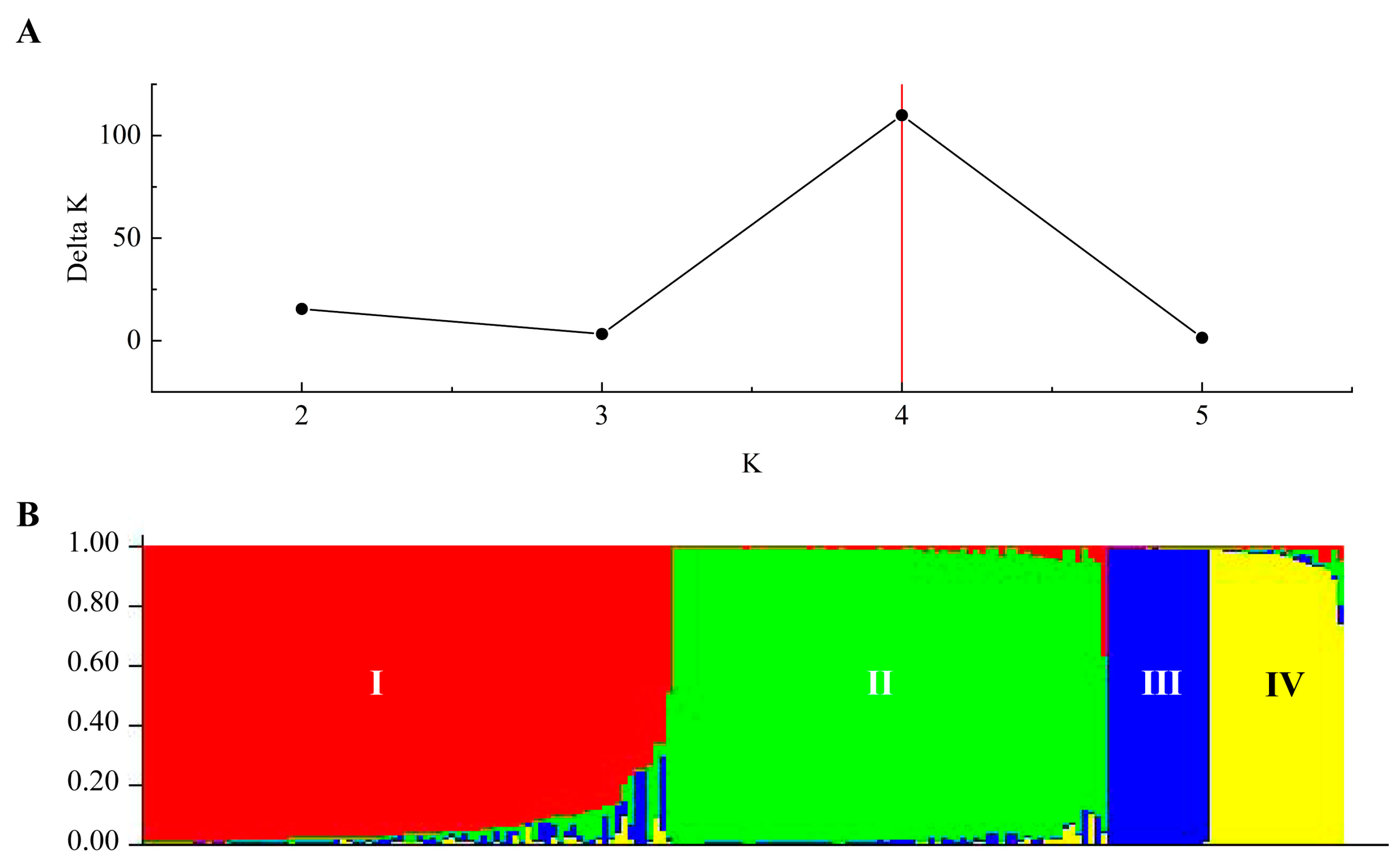


| Locus | Na | Ne | I | Ho | He | PIC | HWE (p) | Fis | Fit | Fst | Nm |
|---|---|---|---|---|---|---|---|---|---|---|---|
| SSR6 | 4 | 2.43 | 1.108 | 0.543 | 0.589 | 0.546 | 0.024 * | 0.000 | 0.065 | 0.065 | 3.567 |
| SSR25 | 8 | 3.56 | 1.530 | 0.601 | 0.719 | 0.686 | 0.000 *** | −0.004 | 0.244 | 0.247 | 0.763 |
| SSR47 | 7 | 2.22 | 0.963 | 0.452 | 0.550 | 0.464 | 0.002 ** | 0.176 | 0.290 | 0.139 | 1.553 |
| SSR58 | 6 | 2.61 | 1.251 | 0.473 | 0.617 | 0.578 | 0.000 *** | 0.006 | 0.205 | 0.201 | 0.995 |
| SSR80 | 7 | 2.15 | 1.059 | 0.505 | 0.534 | 0.488 | 0.002 ** | −0.010 | 0.105 | 0.114 | 1.935 |
| SSR85 | 2 | 1.07 | 0.141 | 0.064 | 0.062 | 0.060 | 0.651 | −0.078 | −0.020 | 0.054 | 4.390 |
| SSR104 | 4 | 1.73 | 0.639 | 0.447 | 0.421 | 0.337 | 0.960 | −0.140 | −0.013 | 0.112 | 1.981 |
| SSR105 | 9 | 1.53 | 0.809 | 0.309 | 0.347 | 0.332 | 0.000 *** | 0.019 | 0.101 | 0.084 | 2.744 |
| SSR117 | 7 | 4.71 | 1.654 | 0.713 | 0.788 | 0.756 | 0.016 * | −0.031 | 0.134 | 0.160 | 1.313 |
| SSR120 | 18 | 10.49 | 2.502 | 0.883 | 0.905 | 0.897 | 0.000 *** | −0.100 | 0.010 | 0.100 | 2.250 |
| SSR126 | 18 | 10.33 | 2.603 | 0.755 | 0.903 | 0.896 | 0.000 *** | −0.036 | 0.074 | 0.106 | 2.108 |
| SSR129 | 9 | 4.35 | 1.751 | 0.691 | 0.770 | 0.742 | 0.000 *** | 0.049 | 0.189 | 0.147 | 1.449 |
| SSR132 | 4 | 3.65 | 1.339 | 0.527 | 0.726 | 0.677 | 0.000 *** | −0.044 | 0.149 | 0.185 | 1.103 |
| SSR139 | 3 | 2.00 | 0.741 | 0.441 | 0.500 | 0.388 | 0.325 | −0.070 | 0.060 | 0.121 | 1.817 |
| SSR143 | 4 | 1.53 | 0.647 | 0.234 | 0.347 | 0.316 | 0.000 *** | 0.340 | 0.435 | 0.144 | 1.484 |
| Total | 110 | 54.36 | -- | -- | -- | -- | -- | -- | -- | -- | -- |
| Mean | 7.33 | 3.62 | 1.249 | 0.509 | 0.585 | 0.544 | -- | 0.005 | 0.135 | 0.132 | 1.964 |
| Provenance | Na | Ne | I | Ho | He | Number of Private Alleles |
|---|---|---|---|---|---|---|
| AM | 3.73 | 2.65 | 0.908 | 0.453 | 0.484 | -- |
| AI | 2.93 | 1.91 | 0.644 | 0.463 | 0.371 | -- |
| AW | 2.67 | 1.92 | 0.609 | 0.371 | 0.344 | -- |
| AQ | 6.13 | 3.05 | 1.133 | 0.505 | 0.551 | 18 |
| AL | 5.00 | 3.36 | 1.130 | 0.583 | 0.562 | 3 |
| AT | 5.33 | 2.99 | 1.160 | 0.550 | 0.589 | 4 |
| Mean | 4.30 | 2.65 | 0.931 | 0.488 | 0.484 | -- |
| Source | df | SS | MS | Est. Var. | Percentage Variation (%) |
|---|---|---|---|---|---|
| Among Provenances | 5 | 170.584 | 34.117 | 0.538 | 11.85 |
| Among Individuals | 182 | 761.693 | 4.185 | 0.183 | 4.03 |
| Within Individuals | 188 | 718.000 | 3.819 | 3.819 | 84.12 |
| Total | 375 | 1650.277 | 4.540 | 100.00 |
| Trait | Locus | df | F-Value | p-Value | Contribution Rate (%) |
|---|---|---|---|---|---|
| H | SSR132 | 9 | 3.051 | 0.002 | 13.09 |
| TB | SSR132 | 9 | 2.918 | 0.003 | 12.62 |
| GD | SSR132 | 9 | 2.848 | 0.004 | 11.77 |
| GD | SSR47 | 8 | 2.906 | 0.005 | 10.75 |
| δ13C | SSR58 | 15 | 1.991 | 0.019 | 13.89 |
| δ15N | SSR126 | 69 | 1.551 | 0.019 | 48.15 |
| δ13C | SSR129 | 27 | 1.723 | 0.022 | 21.13 |
| δ15N | SSR132 | 9 | 2.221 | 0.023 | 10.26 |
| δ15N | SSR80 | 13 | 1.967 | 0.026 | 13.02 |
| δ15N | SSR104 | 4 | 2.764 | 0.029 | 5.79 |
| δ15N | SSR120 | 65 | 1.492 | 0.031 | 44.87 |
| TB | SSR143 | 6 | 2.346 | 0.033 | 7.10 |
| δ13C | SSR117 | 20 | 1.713 | 0.036 | 15.98 |
| H | SSR143 | 6 | 2.248 | 0.041 | 6.81 |
| GD | SSR85 | 1 | 4.092 | 0.045 | 2.02 |
| Mean | 15.82 |
| Trait | Locus | df | F-Value | p-Value | lnLikelihood |
|---|---|---|---|---|---|
| GD | SSR47 | 8 | 2.6707 | 0.009 | −2.70 × 102 |
| SSR85 | 1 | 4.7035 | 0.031 | −2.86 × 102 | |
| δ15N | SSR80 | 12 | 2.1396 | 0.017 | −2.71 × 102 |
Disclaimer/Publisher’s Note: The statements, opinions and data contained in all publications are solely those of the individual author(s) and contributor(s) and not of MDPI and/or the editor(s). MDPI and/or the editor(s) disclaim responsibility for any injury to people or property resulting from any ideas, methods, instructions or products referred to in the content. |
© 2024 by the authors. Licensee MDPI, Basel, Switzerland. This article is an open access article distributed under the terms and conditions of the Creative Commons Attribution (CC BY) license (https://creativecommons.org/licenses/by/4.0/).
Share and Cite
Gao, C.; Chen, C.; Liu, N.; Liu, F.; Su, X.; Liu, C.; Huang, Q. Genetic Diversity and Association Analysis of Traits Related to Water-Use Efficiency and Nitrogen-Use Efficiency of Populus deltoides Based on SSR Markers. Int. J. Mol. Sci. 2024, 25, 11515. https://doi.org/10.3390/ijms252111515
Gao C, Chen C, Liu N, Liu F, Su X, Liu C, Huang Q. Genetic Diversity and Association Analysis of Traits Related to Water-Use Efficiency and Nitrogen-Use Efficiency of Populus deltoides Based on SSR Markers. International Journal of Molecular Sciences. 2024; 25(21):11515. https://doi.org/10.3390/ijms252111515
Chicago/Turabian StyleGao, Chengcheng, Cun Chen, Ning Liu, Fenfen Liu, Xiaohua Su, Chenggong Liu, and Qinjun Huang. 2024. "Genetic Diversity and Association Analysis of Traits Related to Water-Use Efficiency and Nitrogen-Use Efficiency of Populus deltoides Based on SSR Markers" International Journal of Molecular Sciences 25, no. 21: 11515. https://doi.org/10.3390/ijms252111515
APA StyleGao, C., Chen, C., Liu, N., Liu, F., Su, X., Liu, C., & Huang, Q. (2024). Genetic Diversity and Association Analysis of Traits Related to Water-Use Efficiency and Nitrogen-Use Efficiency of Populus deltoides Based on SSR Markers. International Journal of Molecular Sciences, 25(21), 11515. https://doi.org/10.3390/ijms252111515







